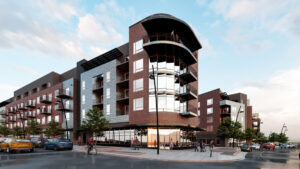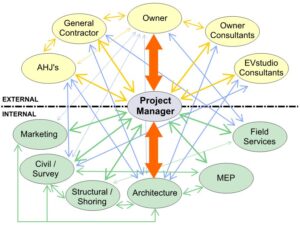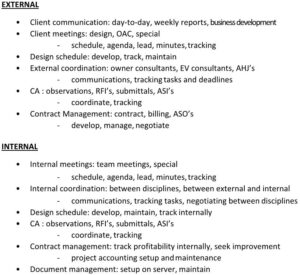Why Have A Project Manager?
In every type of engineering or design outside of building construction the position of Project Manager is omnipresent, yet in the process of design for building construction it is rarely seen. Typically the architect assumes that role, yet not all architects are well-suited to that role, nor even trained for it. Architects are often successful in their practice because of their creative abilities and non-linear thinking. They are not usually recognized for their abilities to manage linear schedules, track administrative details, or manage teams of people. Architects have their role as a designer to fulfill, which often takes priority over project management tasks due to either sheer workload or the architect’s preference to focus on what interests them.


Project Managers Play a Vital Role in Multidisciplinary Projects
Large, multidisciplinary construction projects deserve a dedicated Project Manager (PM) who can focus on keeping all disciplines on schedule and on budget, while designing a quality product for the client. Project Manager roles can vary during design, but often the best PM is one who has experience in the prime discipline of a particular project. This approach allows the PM to use their knowledge to engage in the design process in more than a strictly administrative capacity. And on complex building projects in which aesthetics are a prime driver, especially those with complex entitlement processes, a PM that can also manage non-linear design processes can be invaluable. Although PM’s are tasked with keeping all disciplines on schedule, the ability to creatively adapt to changing timelines can keep a PM from becoming overly frustrated with the regular change that is often present during complex design projects.
At EVstudio we utilize dedicated PM’s for large and complex projects to ensure that information flows smoothly between the Owner and the rest of the design team, and between the various disciplines the project requires. EVstudio offers a variety of disciplines including architectural design, civil, structural, mechanical, plumbing, and electrical engineering, as well as soil retention design and field inspection services. Our projects, large or smaller, often include a mix of in-house and out-of-house disciplines. In all cases, our PM’s ensure clear communication between disciplines, protecting against “silo-ing” and providing well-coordinated designs and documents.
What does a Project Manager Do?

The PM manages the project timeline and the cost of design services, but their primary function is managing communication. This diagram visualizes the flow of information on a typical, large multidisciplinary project for EVstudio, where all available disciplines are in-house. As you can see, the PM is a critical focal point for the flow of information. It is not hard to see how if the architect or one of the engineers filled that role in addition to their own, they could easily become overwhelmed with the tasks in their purview. With PM’s in place, architects and engineers can focus on their design and documentation while the PM manages the overall process of design and communication with the client, Authorities Having Jurisdiction (AHJ’s) and other parties.

On a typical large project, PM tasks, though heavily administrative, are extensive. The image to the right is a list summarizing PM duties on a large project where all available EVstudio disciplines are in-house. This should also make it clear that if an architect were tasked with all these duties, they wouldn’t have much time left over to focus on the design.
To provide the best project management possible for each project, EVstudio utilizes Project Managers with experience in the prime discipline required for that project. An experienced architect for architecture-centric projects or an experienced engineer for engineering-centric projects. This approach provides more tightly integrated design disciplines, more creative design solutions, and more well-coordinated documents while preserving tight compliance to the project’s design timeline and budget, all contributing to the most successful project outcomes for our clients.
For more on project management, please read this article about How to Succeed as a Project Manager.










